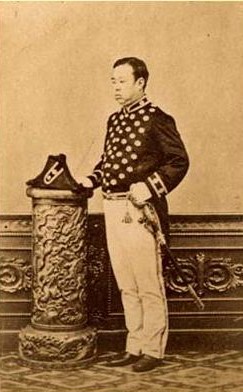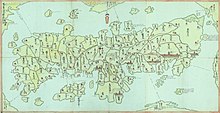Kumamoto Domain
This article currently links to a large number of disambiguation pages (or back to itself). (June 2024) |
The Kumamoto Domain (熊本土間員, Kumamoto-han), wielded significant influence in its region. Initially overseeing 520,000 koku, its territory expanded to 540,000 koku with subsequent divisions and branch domain establishments during the Hosokawa clan’s tenure. By 1871, territorial adjustments saw the domain relinquish control over parts of Higo Province (modern-day Kumamoto Prefecture) and parts of Bungo Province (present-day Oita Prefecture). It’s administrative hub was at Kumamoto Castle in Kumamoto. Despite losing control over Higo, the Hosokawa clan maintained their status as feudal lords, or Daimyo, in the region.[1][2][3][4]
| Kumamoto Domain 熊本土間員 | |
|---|---|
| Domain of Japan | |
| 1600–1871 | |
 Walls of Kumamoto Castle | |
Mon of the Hosokawa clan
| |
 Keep of Kumamoto Castle | |
| Capital | Kumamoto Castle |
| Area | |
| • Coordinates | 32°48′21.7″N 130°42′21.23″E / 32.806028°N 130.7058972°E |
| Government | |
| • Type | Daimyō |
| Daimyō | |
• 1600 - 1611 | Kato Kiyomasa (first) |
• 1870 - 1871 | Hosokawa Morihisa (last) |
| Historical era | Edo period Meiji period |
• Established | 1600 |
• Disestablished | 1871 |
| Today part of | Kumamoto Prefecture |

History[edit]
During the Sengoku period[5], the Kikuchi, Aso, and Sagara clans emerged as powerful clan in the northern, central, and southern regions, respectively, leading to a relatively peaceful period. However, tensions rose when the Aso clan attacked the Kikuchi clan and faced internal conflicts, prompting the Otomo clan from Bungo Province to intervene and pacify the territory. The Sagara clan, known for their defensive prowess, ultimately submitted to the Shimazu clan and adopted advanced weapons and tactics. Following the Shimazu clan's defeat by Toyotomi Hideyoshi, Kato Kiyomasa emerged as a significant figure, solidifying his power with substantial holdings and establishing the Kumamoto Domain. Kumamoto Prefecture[6] was established in 1871 amid the abolition of the han system, with the Hosokawa clan later elevated to the rank of marquis in 1884. In 1983, Hosokawa Morihiro, who would later serve as the 79th Prime Minister of Japan, briefly governed Kumamoto Prefecture before retiring to pursue ceramics.
Kumamotoshinden Domain[edit]
Kumamotoshinden Domain (肥後新田藩), was a branch of the Kumamoto Domain. It was established in 1666 by Hosokawa Toshishige, the younger brother of Hosokawa Tsunatoshi, the third daimyō of the Kumamoto Domain. Toshige received 35,000 koku of rice from the Kumamoto domain's rice store and set up his own domain. Unlike other feudal lords, Toshige resided in Teppozu, Edo and did not practice sankin kotai, the system of alternate attendance. However, with the advent of the Meiji Restoration[7] in 1868, a provisional domain office was established at the Takase Town Magistrate's Office in Tamana City. Consequently, the domain's name was changed to Takase Domain. In 1870, a formal jin'ya, or administrative center, was completed and relocated to Iwasaki in Tamana District. In the same year, the domain was merged with the Kumamoto domain and ultimately abolished.
Holdings at the end of the Edo period[edit]
- Higo Province
- Akata - 177 villages
- Takoma - 59 villages
- Kamimashiki - 201 villages
- Shimomashiki - 191 villages
- Uto - 64 villages
- Ashikita - 204 villages
- Tamana - 257 villages
- Yamamoto County - 62 villages
- Kikuchi - 81 villages
- Koshi - 104 villages
- Yamaga - 67 villages
- Aso - 214 villages
- Yatsushiro County - 91 villages
- Bungo Province
- Oita County - 39 villages
- Kaifu County - 22 villages
- Naoiri County - 2 villages
List of daimyō[edit]
# Name Tenure Courtesy title Court Rank kokudaka  Katō clan, 1600 - 1632 (Tozama daimyo)
Katō clan, 1600 - 1632 (Tozama daimyo)
1 Katō Kiyomasa (加藤清正) 1600 - 1611 Jushiinoge (じゅしいのげ), Higo-no-kami (肥後守) Junior 5th Rank, Upper Grade (従五位下) 520,000 koku 2 Kato Tadahiro (加藤忠弘) 1611 - 1632 Higo-no-kami (肥後守) Junior 5th Rank, Lower Grade (従五位下) 520,000 koku  Hosokawa clan, 1632 - 1871 (Tozama daimyo)
Hosokawa clan, 1632 - 1871 (Tozama daimyo)
1 Hosokawa Tadatoshi (細川忠俊) 1632 - 1641 Jushiinoge (じゅしいのげ), Sakone-no-sho (さこねのしょ) Junior 4th Rank, Lower Grade (従五位下) 540,000 koku 2 Hosokawa Mitsunao (細川満直) 1641 - 1649 Higo-no-kami (肥後守) Junior 4th Rank, Lower Grade (従五位下) 540,000 koku 3 Hosokawa Tsunatoshi (細川綱俊) 1649 - 1712 Etchu-no-kami(越中守) Junior 4th Rank, Lower Grade (従五位下) 540,000 koku 4 Hosokawa Nobunori (細川信則) 1712 - 1732 Etchu-no-kami (越中守) Junior 5th Rank, Lower Grade (従五位下) 540,000 koku 5 Hosokawa Munetaka (細川宗隆) 1732 - 1747 Etchu-no-kami (越中守) Junior 5th Rank, Lower Grade (従五位下) 540,000 koku 6 Hosokawa Shigekata (1718–1785) (細川重方) 1747 - 1785 Ecchu-no-kami(越中守) Junior 5th Rank, Lower Grade (従五位下) 540,000 koku 7 Hosokawa Harutoshi (細川晴敏) 1785 - 1787 Etchu-no-kami (越中守) Junior 4th Rank, Lower Grade (従五位下) 540,000 koku 8 Hosokawa Narishige (細川成成) 1787 - 1810 Ecchu-no-kami (越中守), Izumi no kami (泉の髪) Junior 4th Rank, Lower Grade (従五位下) 540,000 koku 9 Hosokawa Naritatsu (細川成田津) 1810 - 1826 Sakone-no-gon-no-shosho (さこねのゴンの所々), Ecchu-no-kami (越中の髪) Junior 4th Rank, Lower Grade (従五位下) 540,000 koku 10 Hosokawa Narimori (細川斉盛) 1826 - 1860 Ecchu-no-kami (越中守) Junior 4th Rank, Lower Grade (従五位下) 540,000 koku 11 Hosokawa Yoshikuni (細川義国) 1860 - 1870 Etchu-no-kami (越中守) Junior 4th Rank, Lower Grade (従五位下) 540,000 koku 12 Hosokawa Morihisa (細川盛久) 1870 - 1871 -none- Junior 4th Rank, Lower Grade (従五位下) 540,000 koku

- Kumamotoshinden Domain
# Name Tenure Courtesy title Court Rank kokudaka  Hosokawa clan, 1666 - 1870 (fudai daimyo)
Hosokawa clan, 1666 - 1870 (fudai daimyo)
1 Hosokawa Toshishige (細川利重) 1666 - 1687 Wakasa no kami (若さの髪) Junior 5th Rank, Lower Grade (従五位下) 35,000 koku 2 Hosokawa Toshimasa (細川利昌) 1687 - 1715 -none- Junior 5th Rank, Lower Grade (従五位下) 35,000 koku 3 Hosokawa Toshiyasu (細川利恭) 1715 - 1742 Bingo-no-kami (ビンゴの髪 Junior 5th Rank, Lower Grade (従五位下) 35,000 koku 4 Hosokawa Toshihiro (細川利寛) 1742 - 1767 Wakasa-no-kami (若さの髪) Junior 5th Rank, Lower Grade (従五位下) 35,000 koku 5 Hosokawa Toshiyuki (細川利致) 1767 - 1781 Wakasa-no-kami (若さの髪) Junior 5th Rank, Lower Grade (従五位下) 35,000 koku 6 Hosokawa Toshitsune (細川利庸) 1781 - 1805 Noto-no-kami (のとの髪) Junior 5th Rank, Lower Grade (従五位下) 35,000 koku 7 Hosokawa Toshikuni (細川利国) 1805 - 1810 -none- Junior 5th Rank, Lower Grade (従五位下) 35,000 koku 8 Hosokawa Toshika (細川利愛) 1810 - 1833 -none- Junior 5th Rank, Lower Grade (従五位下) 35,000 koku 9 Hosokawa Toshimochi (細川利用) 1833 - 1856 Noto-no-kami (のとの髪) Junior 5th Rank, Lower Grade (従五位下) 35,000 koku 10 Hosokawa Toshinaga (細川利永) 1856 - 1870 Wakasa-no-kami (若さの髪) Junior 5th Rank, Lower Grade (従五位下) 35,000 koku
Genealogy[edit]
- Hosokawa Fujitaka (1534–1610)
- Tadaoki (1563–1645)
 I. Tadatoshi, 1st daimyō of Kumamoto (cr. 1632) (1586–1641; r. 1632–1641)
I. Tadatoshi, 1st daimyō of Kumamoto (cr. 1632) (1586–1641; r. 1632–1641)
- Tatsutaka (1615–1645)
- Yukitaka, 1st daimyō of Udo (1637–1690)
- Aritaka, 2nd daimyō of Udo (1676–1733)
- Okinari, 3rd daimyō of Udo (1699–1737)
- Okinori, 5th daimyō of Udo (1723–1785)
 VIII. Narishige, 6th daimyō of Udo, 8th daimyō of Kumamoto (1755–1835; r. 1787–1810)
VIII. Narishige, 6th daimyō of Udo, 8th daimyō of Kumamoto (1755–1835; r. 1787–1810)
- Tatsuyuki, 7th daimyō of Udo (1784-1818)
 X. Narimori, 8th daimyō of Udo, 10th Lord of Kumamoto (1804–1860; r. 1826–1860)
X. Narimori, 8th daimyō of Udo, 10th Lord of Kumamoto (1804–1860; r. 1826–1860)
 XI.Yoshikuni, 11th daimyō of Kumamoto, 25th Hosokawa family head (1835–1876; r. 1860–1869. Governor of Kumamoto 1869–1871).
XI.Yoshikuni, 11th daimyō of Kumamoto, 25th Hosokawa family head (1835–1876; r. 1860–1869. Governor of Kumamoto 1869–1871).- Morihisa, 26th Hosokawa family head, 1st Marquess (1839–1893; family head 1876–1893; 1st Marquess Hosokawa: 1884–1893)
- Morishige, 27th Hosokawa family head, 2nd Marquess (1868–1914; family head and 2nd Marquess 1893–1914)
- Morikei, 1st Baron Hosokawa (cr. 1896) (1882–1898)
- Moritatsu, 28th Hosokawa family head, 3rd Marquess, 2nd Baron (1883–1970; 2nd Baron Hosokawa 1898, 14th Hosokawa family head 1914–1970, 3rd Marquess 1914–1947)
 IX. Naritatsu, 9th daimyō of Kumamoto (1788–1826; r. 1810–1826)
IX. Naritatsu, 9th daimyō of Kumamoto (1788–1826; r. 1810–1826)
- Tatsuyuki, 7th daimyō of Udo (1784-1818)
- Okinori, 5th daimyō of Udo (1723–1785)
- Okinari, 3rd daimyō of Udo (1699–1737)
- Aritaka, 2nd daimyō of Udo (1676–1733)
- Yukitaka, 1st daimyō of Udo (1637–1690)
- Tadaoki (1563–1645)
<ref>Genealogy</ref
See also[edit]
References[edit]

- ^ Hellyer, Robert; Fuess, Harald (2020-05-07). The Meiji Restoration: Japan as a Global Nation. Cambridge University Press. ISBN 978-1-108-80047-1.
- ^ Cobbing, Andrew (2008-12-18). Kyushu: Gateway to Japan: A Concise History. Global Oriental. ISBN 978-90-04-21312-8.
- ^ Yamaji, Aizan (2020-08-06). Essays on the Modern Japanese Church: Christianity in Meiji Japan. University of Michigan Press. ISBN 978-0-472-90191-3.
- ^ Lewis, James B. (2014-12-05). The East Asian War, 1592-1598: International Relations, Violence and Memory. Routledge. ISBN 978-1-317-66274-7.
- ^ Chaplin, Danny (2018). Sengoku Jidai. Nobunaga, Hideyoshi, and Ieyasu: Three Unifiers of Japan. CreateSpace Independent Publishing Platform. ISBN 978-1-9834-5020-4.
- ^ Prefecture, Kumamoto (1967). Products of Kumamoto Prefecture, Japan /ʹcKumamoto Prefecture. Kumamoto Prefectural Government.
- ^ Hellyer, Robert; Fuess, Harald (2020-05-07). The Meiji Restoration: Japan as a Global Nation. Cambridge University Press. ISBN 978-1-108-47805-2.
External links[edit]
![]() Media related to Kumamoto Domain at Wikimedia Commons
Media related to Kumamoto Domain at Wikimedia Commons



